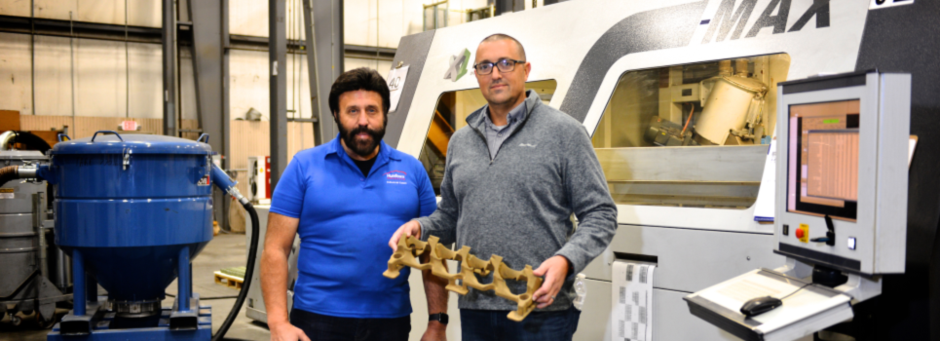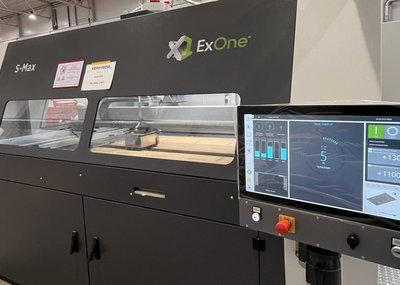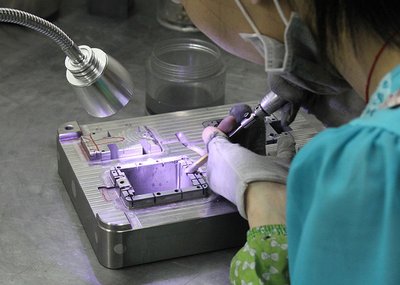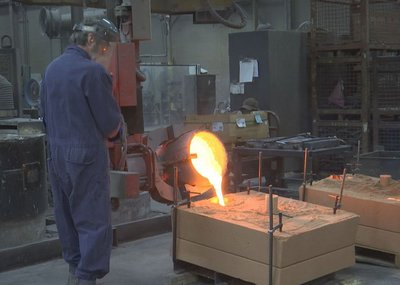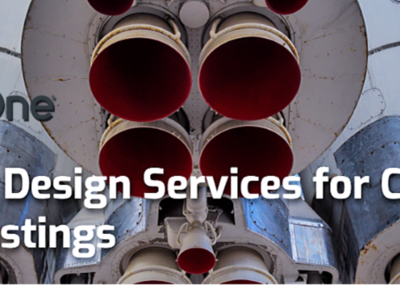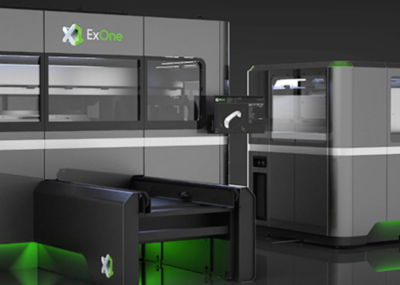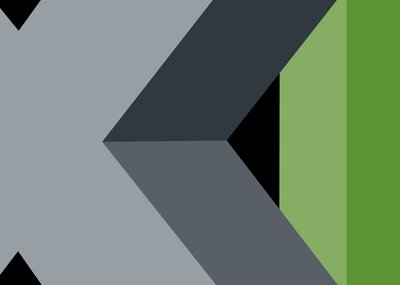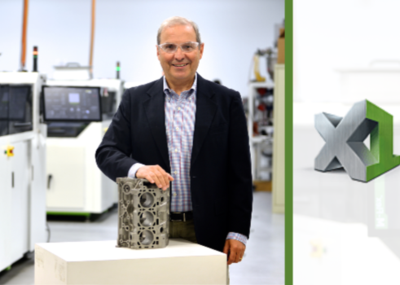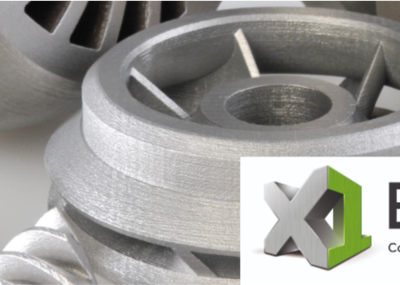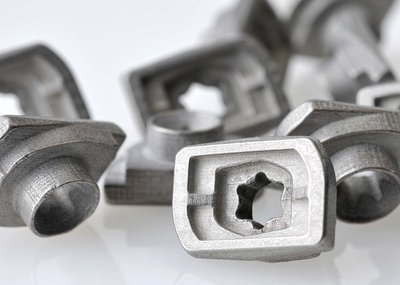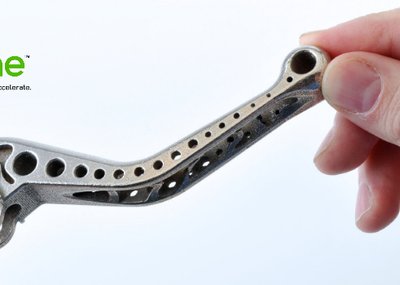A few years after the Great Recession of 2008, Mark Lamoncha, president of a modest Ohio business making patterns, molds and cores for a shrinking foundry industry, made a risky decision that he hoped would re-energize the business founded in 1959 by his father and help it thrive under its third generation led by his son, Brandon.
On paper, the math didn’t make perfect financial sense, but the industry was changing and presenting new challenges. The number of U.S. foundries was dropping, from about 5,000 during the heyday enjoyed by his father, Russell, to about 900.
So, Lamoncha decided to take a risk, and in 2016, he partnered with Youngstown State University and America Makes to install a sand 3D printer — an S-Max from The ExOne Company — in his facility. The new machine directly printed sand molds and cores from digital design files, which his foundry customers would use to pour metalcastings.
“When I saw this, I could see there was a better future,” Mark Lamoncha said. “I knew it was worth taking a risk – it’s just so much more efficient. You could make a core without a mold, and you could make a sand mold without a pattern. It was a technology that almost seemed too long in coming. This was the way cores were meant to be made.”
Relatively speaking, the S-Max was much more expensive than the equipment that Humtown typically purchased to create sand cores. But Lamoncha was progressive in seeing the new technology as simplifying the whole end-to-end process in a way that would ultimately save him money.
The new machine promised to reduce labor, scrap, repair, inventory, and allow him to deliver products to customers much faster, including parts that were once impossible to make — enabling him to win new business.
“The whole timeline is considerably shorter,” Mark Lamoncha explained, noting it’s usually 2-5 days to get a core 3D printed versus a few weeks with a blown core and what could be several months for a mold to create that core. Plus, he noted, “You’re not creating all these materials that are going into landfills.”
A New Business Outlook
Fast forward to 2020, and Lamoncha’s risk has exceeded all expectations.
Humtown now has three S-Max 3D printers, housed in a large, repurposed factory to accommodate their growth. Mark and Brandon said they are completely sold on the benefits of 3D printing, and, more importantly, the added value it’s helping them provide to foundries and manufacturers.
“My grandfather would be so incredibly proud to see what we’re doing today. I think he’d be shocked that we could get a casting in days without a pattern or core mold,” Brandon Lamoncha said, while walking through the company’s 3D printing facility in Leetonia, Ohio. It’s just a short drive from the company’s original conventional pattern— and core-making facility in Columbiana, which is also thriving and seen as a compliment to the 3D printing operations.
With its new 3D printing technology, Humtown now supplies sand molds and cores for metalcasting to foundries all over the United States, as well as the rest of the Americas, Asia and even, sometimes, to Europe. What’s more, Humtown believes it’s now the largest producer of sand cores in the United States, and the company’s 3D printers transform 125 tons of sand a month into molds and cores for foundries to pour metal parts. That’s equal to about a rail car each month.
“3D saved the day, and ExOne was the catalyst,” Brandon said. “We’ve had a lot of really good success.”
Just as valuable as the new business, Brandon notes, is the way companies now view Humtown as a leader in additive manufacturing.
“It has catapulted the way customers think of us,” Brandon Lamoncha said. “Additive manufacturing has given us not just the ability to work with tier two and three suppliers, but we’ve also signed well over 100 NDAs with world-leading, global OEMs on additive projects.”
Many of those projects involve additive manufacturing consulting work, where Lamoncha gives guidance about how much more complexity can now be created in new part designs, as well as the benefits of 3D printed consolidated cores – a major advantage of the new 3D printed equipment.
Understanding the Full Benefits
Looking back, Mark Lamoncha said one reason he was so convinced 3D printing would be a winning investment – even though he couldn’t fully calculate the financial benefit at the time – was that he was looking at the full picture when making his purchase decision. He simply believed the whole process was more efficient and would deliver higher quality and lower costs.
Looking at cores alone, for example, a core shooting machine tool retails for about $100,000 and it costs an estimated 2-3 cents per cubic inch for a part. These machines essentially blow sand mixed with wet binder into a mold, and they can quickly churn out sand cores for metalcasting.
At face value, these machines may seem much more affordable than a 3D printer that retails for over $1 million, which would seem to put the cost per cubic inch at a noncompetitive value of 12-14 cents per cubic inch for the 3D printer.
But when taking into account the broad range of savings for complex molds and cores, the technology is highly competitive and also opens up new business opportunities. As Mark Lamoncha explained: “Some people don’t consider all the costs.”
The True Cost of Traditional Cores
To understand the true financial benefit of 3D printing sand cores, you have to really understand the full costs of the traditional manufacturing method. When producing a core with a core shooter, you start with a mold, which costs extra time and money to create. These molds are typically CNC’d out of wood, plastic or metals, depending on the required volumes. Whenever you create a mold using a subtractive method, you are paying material cost for the mold, machining time and expenses, as well as the material waste that comes with machining because all of the waste must be disposed of or recycled.
If the core is complex, the desired core shape is usually broken into several parts that will later be assembled together. This is done strictly because it’s difficult to machine a complex mold in one piece, or blow wet sand into a very complex mold in one piece. So, the part is broken into separate pieces for manufacturability. This requires extra design work and more mold parts for each separate piece.
Once the core parts are blown, there is also a cost to assemble separate core pieces together. This requires labor, as well as jigs and fixtures that must be manufactured to help ensure proper placement of the assembled pieces. These additional parts come with the same costs as a mold: materials, machining time and waste. What’s more, they’re built for a single purpose and aren’t needed after the job is complete.
Then there are the quality considerations. If the part is truly complex, the failure, scrap and repair rate of the part coming out of the core shooter can be high. Depending on who you ask, the waste can range anywhere from 5-20% — even more for very complex designs. That is simply because it can be challenging to extract a complex core from the mold.
Additionally, molds for traditional core shooters deteriorate very quickly because they are basically being blown full of wet sand, which is akin to sand blasting. That means that the part quality often deteriorates as volumes increase. “With the old conventional tooling, every time you use it, you’re wearing the tool out. So, you always have to check it for wear and tolerances,” Mark Lamoncha explained.
A High Efficiency & Quality Solution
With 3D printing, every one of these costs and concerns is reduced, if not eliminated. There are no patterns, molds, jigs or fixtures. Core shapes don’t need to be broken into pieces for manufacturability. There’s also no labor to assemble pieces or repair a core part that might not have extracted perfectly from the mold.
“With 3D printing, every part is always right,” Mark said. “Quality remains high across the entire production run, including years down the road when you have to make the part again and just start with the digital file.”
Brandon Lamoncha explained that customers also don’t have to pay to store a pattern or mold after the job is complete, which is commonly saved in case the same part needs to be manufactured again later. They also don’t have to assess the quality of that inventory when they need to use again at a later date, and they don’t have to worry about it being damaged or lost.
Even better, if the customer wants to tweak the design, they don’t have to scrap their investment in patterns, molds or jigs and fixtures. They can just print the new design or easily improve it if they want.
Complexity is Key to Savings
But the biggest value with the 3D printing technology comes with new complex designs and consolidating complex cores into one part that does not require core assembly.
“We have clients making more consolidated sand cores in production,” said Brandon Lamoncha. “Now, you’re only limited by your own imagination.”
Rich Lonardo of Defense & Energy Systems, an engineering consultancy in Youngstown, Ohio, said the Lamonchas realized this technological change was bigger than just 3D printing molds and cores the way they’ve always been done. Because they had a deep understanding of the business, he said, the Lamonchas realized that they could 3D print complex, consolidated cores and deliver better parts much easier than when using the the traditional method.
“They’ve truly validated the impact of this technology,” Lonardo said.
Foundries now partner with Humtown because they produce parts very rapidly — sometimes of designs that cannot be done with conventional coremaking processes. This allows them to do new types of work and serve their manufacturing customers even better.
Bob Braun of Wisconsin Aluminum Foundry said, “We’ve been able to give a casting to a customer in less than two weeks, which is pretty amazing lead time. So the service and rapid turnaround times are a key selling point.”
Tom Kayser of Osco Industries, a mining and metals company in Portsmouth, Ohio, said that manufacturing customers have just begun to scratch the surface of the new possibilities 3D printing offers for making complex molds and cores.
What’s more, even when a customer doesn’t want to exploit the full advantages of 3D printing, Humtown’s sand 3D printers continue to play a role. “We’re also filling in on bridge production while customers wait for their tooling to be made, which can take 16 to 20 weeks,” Brandon said. “We’ve been able to help customers continue to sell equipment while they wait on their tooling.”
A New Vision for the Future
For Humtown, sand 3D printing has opened a new door for the company – one in which the company’s courageous early adoption of a new technology has given their team special expertise in additive manufacturing.
Brandon and Mark Lamoncha said that expertise is transferable to other forms of additive manufacturing, and they now see themselves building a complete new additive manufacturing facility in their new building, the former home of Mitsubishi Heavy Industries of America Tire Machinery Division. “I think we can fill this whole building with sand and metal 3D printers,” said Mark Lamoncha. “It’s very exciting.”
For a company whose prospects were once dimming, the outlook is now bright. “So many people allow a problem to consume them, when they really need to reduce it down and create a solution by creating a new possibility with a lot of positivity,” said Mark Lamoncha.
Barb Ewing, CEO of the Youngstown Business Incubator, said Humtown is an example of how manufacturing technology can transform American manufacturing. “The company that we point to as the company that’s taken a traditional manufacturing business in a very traditional industry – one that hasn’t fundamentally changed in thousands of years – and completely transformed itself
for the future, is Humtown,” she said. “Mark Lamoncha has redefined it not only for himself and his company but the foundry industry.”
To learn more, please visit: https://www.exone.com/en-US/Case-Study-Humtown-Products

